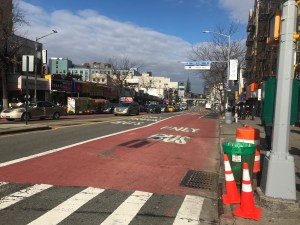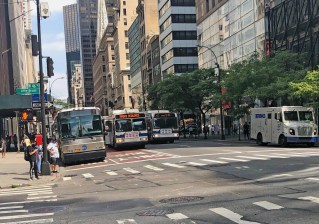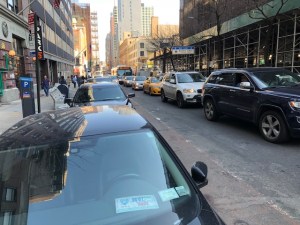So Far, So Good: Early Results Show Faster Transit Trips on Jay Street Busway

All of this has happened before, and all of this will happen again.
The first check-in on the Jay Street Busway shows that, like its cousin on 14th Street, the bus-priority street has increased bus speeds and cut down on car traffic.
According to the DOT’s most recent community advisory board presentation on the city’s newest busway, data from the week of Sept. 28 showed buses on Jay Street are moving faster than 6 MPH between Tillary and Fulton streets during the morning and evening rush hours — up from an average of 4 MPH for the seven bus routes using Jay Street before the busway rules began on Aug. 31.
In addition, southbound buses on Jay Street are moving faster than 6 MPH, and northbound buses are moving just under 6 MPH, a marked improvement on the pre-busway average of just over 3 miles per hour in one of Brooklyn’s most-congested corridors.
Car traffic on Jay Street has also fallen dramatically according to DOT data. Per the October presentation, the DOT observed just over 150 cars between 8 a.m. and 8:30 a.m. and about 200 cars between 5:30 p.m. and 5:30 p.m. on Aug. 18, before the busway rules went into effect. By Sept. 15, car volume had fallen to under 100 cars in the same observation slots.
Busway rules require car drivers to make the first available turn off the busway between 7 a.m. and 7 p.m.
A Streetsblog visit to the busway during Wednesday’s morning rush found that car traffic still existed, and drivers still used the unprotected stretch of the bike lane as a drop-off lane. Still, traffic also flowed around the area, and traffic enforcement agents gave out tickets to cars parked in a No Standing zone/bus stop on Jay Street near Pearl Street (or, private cars anyway, since NYPD officers engaging in their favorite hobby, parking in bus stops. got to leave their SUVs in the way).

People on bikes and scooters were also a regular sight on Smith Street and Jay Street, reflecting the street’s importance as a link to the Manhattan Bridge, which has seen an increase in use as the city’s bike boom has continued.

The one dark blot on the busway right now is the northbound approach on Smith Street, between Bergen and Livingston streets. On that stretch, bus speeds haven’t budged compared to 2019, which the DOT suggested was the result of a temporary protected bike lane that cut the amount of northbound lanes from two to one. Drivers moving north on that stretch also seemed more likely to ignore the private vehicle prohibition compared to drivers going east or west on Livingston, who obeyed posted signs prohibiting turns onto Smith Street.
A B61 driver told Streetsblog that the drivers who kept using Smith were a frustration and caused congestion, and wondered why the city wasn’t doing more to stop it.
“Once in a while you see the police pull someone over,” the bus driver said. “They had a traffic cop on the corner, but I don’t know what happened to them. One minute they were there, and after that they were gone.”
Small hiccups aside, bus riders on Smith Street and Jay Street are probably among the more fortunate in the city. None of the other four busways that Mayor de Blasio promised in June has been built yet:
- The busway on Main Street in Flushing was supposed to be implemented in June, and then in October, but has stalled.
- The Jamaica Avenue busway was slowed down after elected officials asked for it to be moved to Archer Avenue.
- The Fifth Avenue Busway was watered down at the behest of luxury retailers to allow through traffic, and is no longer even a busway.
- The 181st Street Busway in Washington Heights is, in theory, still scheduled for fall 2020 as was originally planned, but October’s community advisory board presentation on the project has not been scheduled yet.
The success of the Jay Street busway reminds us of the Streetsblog Carolers’ performance of “The Busway Works” at Gracie Mansion last year. Enjoy:




